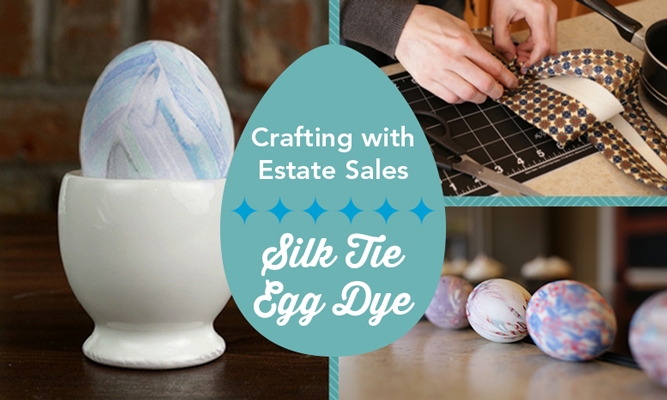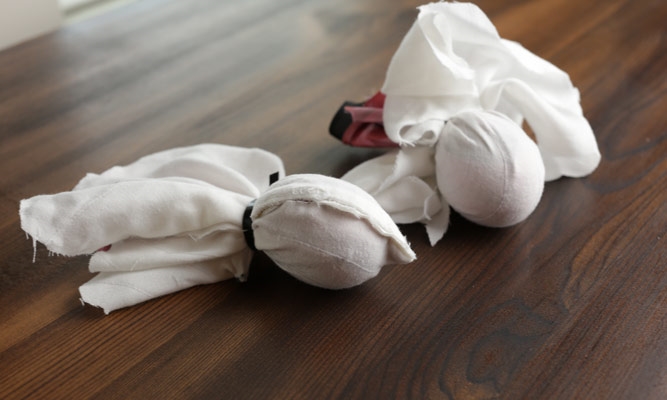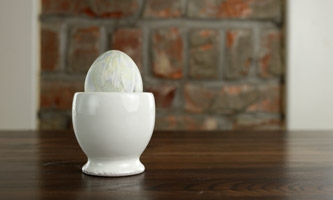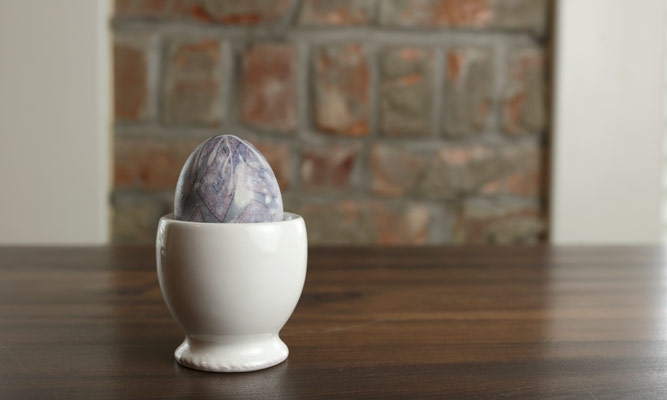Silk Tie Egg Dye

It’s almost Easter, which means it’s about time to bust out the vinegar and egg dying kit and get to work.
“The thing about dying Easter eggs,” my daughter said over a fresh carton of white eggs, a rare sight in my brown-egg home, “is when you buy a kit, everything is basically already done for you.”
Well, my child, you have been blessed with a mother who desperately wants to be Pinteresting, so we shall eschew the traditional fizzy color tabs for our egg-dying needs and instead harness the power of estate sales to reach our goal!

Buckle up, buttercup.
Did you know you can use old silk ties (or scarves, or shirts, or skirts, or...you get the point) to dye your eggs? The patterns transfer imperfectly but beautifully onto to the eggs. Sure, they’re rendered inedible, but does anyone really ever eat all those eggs after the holiday is over? Be honest.
The process is a bit more time consuming than dropping a fizzy pill into a glass of vinegar water, but the results are more unpredictable, and therefore more exciting. And, frankly, more rewarding.
So let’s get started.

First, select a good assortment of silk ties (or robes or shorts, yadda yadda). Look through the closets of your next local estate sale and you’re liable to find some. They don’t have to suit your sartorial style—ugly ties make beautiful eggs. But they do have to be 100% silk, which is usually printed clearly on one of the tags on the back of the tie.
But don’t spend a lot of money on your ties—they will be unusable by the time we’re done.
While you’re shopping for silks, also keep a look out for white bed linens. You’ll need those, too. Again, they will be destroyed, so don’t get too attached or invested.

With a seam-ripper or a handy-dandy pair of scissors, start disassembling the ties, cutting along the back seam, and removing the inner fabric. We want to cut it down to only the silk.
Next, wrap the tie around an uncooked egg, with the outer side of the tie against the egg. Make sure as much of the tie is flat against the egg as possible—if it doesn’t touch, the color won’t transfer. I found it easiest to wrap the egg starting at the bottom of the tie, and then cut of the excess and use it on another egg. You might choose to pre-cut the tie and attempt to maximize the number of eggs you can dye with it. Not me. I like to live fast and loose.

Twist the tie around the egg and secure it at the top. Or the bottom, Or the back. Wherever you secure it, the pattern will be a less solid, and a bit more swirly. So if you plan to display your eggs in a certain way, take this into consideration.
To secure the tie, you can use string, which can be a bit cumbersome, or twist ties, which would be less so. I tried a few different methods, but my closure-of-choice was the zip-tie. Sure, removing them can be difficult, but they make the whole process feel a bit more extreme. After all, I’ve only used zip ties to hold the bumper onto the frame of my car after an accident, and now I’m using them to make delicate eggs. Hardcore, right?
Next, repeat the process with white linens. Wrap the sheet around the tie-wrapped egg, and string- twist- or zip-tie it closed.

They're kind of cute like this, in their own way....
Next, put the eggs into a large pot. Fill the pot with water an inch or two above the eggs, and then add a splash of vinegar. (I like to avoid using measuring cups and spoons because it makes me feel like I know my way around a kitchen. Usually it means cookies and cakes of questionable consistency, but that never stops me from trying again. But if you don’t like to roll that way, use ¼ cup of vinegar.)
Bring the wrapped eggs to a boil and let them cook for 20 minutes.
Drain the water, and with hot tongs (or, in my case, brave fingers) lift the eggs out of the pot and place them onto a dry towel and allow them to cool.
When they're cool enough to comfortably handle, the fun part begins: unwrapping the eggs to see how they turned out. I’m sure I don’t need to warn you to be careful: the eggs are fragile and can break easily. But be careful: the eggs are fragile and can break easily.
(I broke at least four in a rush to unwrap them.)

But darn if I’m not thrilled with the eggs that I didn’t destroy!
Here are a few tips to keep in mind when you start off on your own tie-dying adventure. (Get it? TIE dye?!)

The darker the tie, the more vibrant the egg. I chose several pink and pastel ties in a nod to the season, but the results on the egg were a little too pastel for my tastes (see photo).
I wondered if the white linen step was really necessary. It is. The color won’t be nearly as vibrant nor the pattern as solid if you skip this step. You will be disappointed. Don't do that.

My biggest egg-breaking downfall was not properly removing the zip ties and instead attacking the wet cloth with a pair of scissors, which ultimately pushed into the fragile egg, because I am impatient and Pinteresting only in spirit, not in practice. Don’t do this.
Don’t be afraid of patterns. My black Valentine’s Day tie covered in candy hearts ended up being the most vibrant and exciting of the bunch. I also found a safari-themed tie with jungle cats reclining in the sun. The cheetahs transferred perfectly onto the egg. I was elated. I ran around the house, showing my husband, my child, my dogs, and my cats (who didn't even pretend to care because cats are jerks).
And then I broke it.
I can’t stress tip #3 enough, y’all.
- Just to reiterate, because it’s important: do not eat these eggs. They have been cooked much too long. More importantly, as far as I'm aware, silk ties are not foodsafe. I think it's safe to say they lack the eggy goodness of traditional hardboiled eggs.

But golly, they're pretty.
If you want to truly impress your guests this holiday season, and move away from the solid-colored eggs the mainstream egg-dying conglomerates want you to believe is your only option, then do it yourself, and start by shopping local by visiting your neighborhood estate sale.